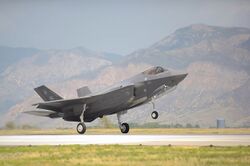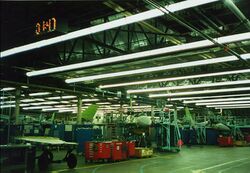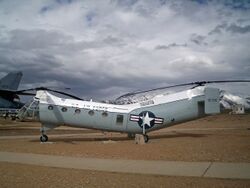This article needs additional citations for verification. (February 2013) |
| Hill Air Force Base | |||||||
|---|---|---|---|---|---|---|---|
| Ogden, Utah in United States of America | |||||||
 A F-35A Lightning II of the 388th Fighter Wing touches down at Hill Air Force Base during 2015. | |||||||
 | |||||||
| Lua error in Module:Location_map at line 408: Malformed coordinates value. | |||||||
| Type | US Air Force Base | ||||||
| Site information | |||||||
| Owner | Department of Defense | ||||||
| Operator | US Air Force | ||||||
| Controlled by | Air Force Materiel Command (AFMC) | ||||||
| Condition | Operational | ||||||
| Website | www.hill.af.mil | ||||||
| Site history | |||||||
| Built | 1939 – 1940 | ||||||
| In use | 1940 – present | ||||||
| Garrison information | |||||||
| Current commander | Colonel Jeffrey Holland[1] | ||||||
| Garrison |
| ||||||
| Airfield information | |||||||
| Identifiers | IATA: HIF, ICAO: KHIF, FAA LID: HIF, WMO: 725755 | ||||||
| Elevation | 1,459.6 metres (4,789 ft) AMSL | ||||||
| |||||||
| Source: Federal Aviation Administration[2] | |||||||
Hill Air Force Base (IATA: HIF, ICAO: KHIF, FAA LID: HIF) is a major U.S. Air Force (USAF) base located in Davis County, Utah, just south of the city of Ogden, and bordering the Cities of Layton, Clearfield, Riverdale, Roy, and Sunset with its largest border immediately adjacent to Clearfield and Layton. It is about 30 miles (48 km) north of Salt Lake City. The base was named in honor of Major Ployer Peter Hill of the U.S. Army Air Corps, who died test-flying NX13372, the original Model 299 prototype of the B-17 Flying Fortress bomber. As of 2018, Hill AFB is the sixth-largest employer in the state of Utah.[3] Hill AFB is the home of the Air Force Materiel Command's (AFMC) Ogden Air Logistics Complex (OO-ALC) which is the worldwide manager for a wide range of aircraft, engines, missiles, software, avionics, and accessories components. The OO-ALC is part of the Air Force Sustainment Center.
The host unit at Hill AFB is the AFMC's 75th Air Base Wing (75 ABW), which provides services and support for the OO-ALC and its subordinate organizations. Additional tenant units at Hill AFB include operational fighter wings of Air Combat Command (ACC) and Air Force Reserve Command (AFRC).
History
Hill Air Force Base is named in honor of Major Ployer Peter Hill (1894–1935), the Chief of the Flying Branch of the U.S. Army Air Corps (USAAC) Material Division of Wright Field, Dayton, Ohio. Major Hill had died as a result of injuries he received from the crash of the Boeing Aircraft Company's experimental aircraft Boeing Model 299 at Wright Field, the prototype airplane for what became the famous B-17 Flying Fortress.
Hill Air Force Base traces its origins back to the ill-fated U.S. Army's Air Mail "experiment" of 1934 when the idea originated for a permanent air depot in the Salt Lake City area. In the following years, the USAAC surveyed the region for a suitable location for the permanent western terminus of the air mail. Several sites in Utah were considered, and the present site near Ogden emerged as the clear favorite.
In July 1939, Congress appropriated $8.0 million for the establishment and construction of the Ogden Air Depot. Hill Field officially opened on 7 November 1940.
Following American entry into World War II in December 1941, Hill Field quickly became an important maintenance and supply base, with round-the-clock operations geared to supporting the war effort. Battle-worn warplanes like the A-26, B-17, B-24, B-29, P-40, P-47, P-61, were sent to Hill Field for structural repairs, engine overhauls, and spare parts. The peak wartime employment at Hill Field was reached in 1943 with just over 22,000 military and civilian personnel. Men and women at the depot rehabilitated and returned thousands of warplanes to combat.
Starting in 1944, Hill Field was utilized for the long-term storage of surplus airplanes and their support equipment, including outmoded P-40 Tomahawks and P-40 Warhawks which had been removed from combat service and replaced by newer and better warplanes. P-47 Thunderbolts, B-24 Liberators, B-29 Superfortresses, and many other types of aircraft were also prepared for and placed in storage at Hill throughout the 1940s and 1950s.
Hill Field became the Hill Air Force Base on 5 February 1948, following the creation of the United States Air Force. During the Korean War, Hill AFB was assigned a major share of the Air Materiel Command's logistical effort to support the combat in Korea. Hill AFB personnel quickly removed needed warplanes from storage, renovated them, and added them to active-service USAF flying squadrons.

Then during the 1960s, Hill AFB began to perform maintenance support for various kinds of jet warplanes, mainly the F-4 Phantom II during the Vietnam War, and then afterward, the more modern F-16 Fighting Falcon, A-10 Thunderbolt II and C-130 Hercules, and also air combat missile systems and air-to-ground rockets. Hill AFB continues to carry out these tasks to the present day.
Major commands assigned
- Materiel Div, Office of Chief of the Air Corps, 1 December 1939 – 11 December 1941
- Air Service Command, 11 December 1941 – 17 July 1944
- AAF Materiel and Services, 17 July 1944 – 31 August 1944
- Army Air Forces Technical Service Command, 31 August 1944 – 1 July 1945
- Air Technical Service Command, 1 July 1945 – 9 March 1946
- Air Materiel Command, 9 March 1946 – 1 April 1961
- Air Force Logistics Command, 1 April 1961 – 1 June 1992
- Air Force Materiel Command 1 June 1992 – present
Base operating units
- Ogden Air Depot, 7 November 1940 – 8 April 1942
- 9th Station Complement, 8 April 1942 – 2 January 1943
- 482d Base HQ and Air Base Sq, 2 January 1943 – 1 April 1944
- 4135th AAF Base Unit, 1 April 1944 – 26 September 1947
- 4135th AF Base Unit, 26 September 1947 – 27 August 1948
- HQ and HQ Sq, Ogden AMA, 27 August 1948 – 4 May 1950
- 25th Air Base Gp, 4 May 1950 – 1 May 1953
- 2849th Air Base Wg, 1 May 1953 – 8 July 1964
- 2849th Air Base Gp, 8 July 1964 – 1994
- 75th Air Base Wing 1994 – present
Role and operations
Ogden Air Logistics Complex
The Ogden Air Logistics Complex provides worldwide engineering and logistics management for the F-35 Lightning II, F-16 Fighting Falcon, A-10 Thunderbolt II, and Minuteman III intercontinental ballistic missile.
75th Air Base Wing
The 75th Air Base Wing is responsible for the base operating support of all units at Hill AFB. The 75th ABW provides base operating support for the Ogden Air Logistics Complex, the 388th and 419th Fighter Wings, and 50+ mission partner units.
Hill Aerospace Museum
Hill AFB has also housed the 30-acre (120,000 m2) Hill Aerospace Museum since 1981. This contains more than 80 retired USAF, U.S. Army Air Forces, U.S. Navy and former Warsaw Pact fixed-wing aircraft, helicopters, and missiles.
Utah Test and Training Range
The Utah Test and Training Range is one of the only live-fire U.S. Air Force training ranges within the United States. It is located in far western Utah, close to the Nevada border, and it extends both north and south of Interstate Highway 80, with several miles of separation on each side of the Interstate Highway. The portion of the bombing range that lies north of Interstate 80 is also west of the Great Salt Lake. The Utah Test and Training Range lies in Tooele County, and the land is owned by the state of Utah, but the use of the airspace and training exercises are scheduled by Hill AFB.
On September 8, 2004, the National Aeronautics and Space Administration's Genesis space probe crash-landed on the nearby U.S. Army Dugway Proving Ground, as planned.
Based units
Flying and notable non-flying units based at Hill Air Force Base.[4][5][6][7][8]
Units marked GSU are Geographically Separate Units, which although based at Hill, are subordinate to a parent unit based at another location.
United States Air Force
|
Air Force Materiel Command (AFMC)
|
Air Combat Command (ACC)
Air Force Reserve Command (AFRC)
|
Accidents and Incidents
- October 19, 2022: An Lockheed Martin F-35 Lightning II crashed off the end of runway 14. The 388th Fighter Wing has stated that the solo pilot was seen by a local hospital and released with no injuries.[9]
- June 20, 1998: An F-16C Falcon Crashed after taking off from the runway during a routine test flight. The F-16 from the 514th Test Squadron was destroyed, pilot ejected with minor injuries.[10]
See also
References
![]() This article incorporates public domain material from the Lua error in Module:Citation/CS1/Configuration at line 2123: attempt to index field '?' (a nil value).
This article incorporates public domain material from the Lua error in Module:Citation/CS1/Configuration at line 2123: attempt to index field '?' (a nil value).
- ↑ Lua error in Module:Citation/CS1/Configuration at line 2123: attempt to index field '?' (a nil value).
- ↑ Lua error in Module:Citation/CS1/Configuration at line 2123: attempt to index field '?' (a nil value).
- ↑ Lua error in Module:Citation/CS1/Configuration at line 2123: attempt to index field '?' (a nil value).
- ↑ Lua error in Module:Citation/CS1/Configuration at line 2123: attempt to index field '?' (a nil value).
- ↑ Lua error in Module:Citation/CS1/Configuration at line 2123: attempt to index field '?' (a nil value).
- ↑ Lua error in Module:Citation/CS1/Configuration at line 2123: attempt to index field '?' (a nil value).
- ↑ Lua error in Module:Citation/CS1/Configuration at line 2123: attempt to index field '?' (a nil value).
- ↑ Lua error in Module:Citation/CS1/Configuration at line 2123: attempt to index field '?' (a nil value).
- ↑ Lua error in Module:Citation/CS1/Configuration at line 2123: attempt to index field '?' (a nil value).
- ↑ Lua error in Module:Citation/CS1/Configuration at line 2123: attempt to index field '?' (a nil value).
Note: Much of this text in an early version of this article was taken from pages on the Hill Air Force Base Website, which as a work of the U.S. Government is presumed to be a public domain resource. That information was supplemented by:
- Mueller, Robert (1989). Active Air Force Bases Within the United States of America on 17 September 1982. USAF Reference Series, Maxwell AFB, Alabama: Office of Air Force History. ISBN 0-912799-53-6
- Ravenstein, Charles A. (1984). Air Force Combat Wings Lineage and Honors Histories 1947–1977. Maxwell AFB, Alabama: Office of Air Force History. ISBN 0-912799-12-9.
External links
- Official website
- FAA Airport Diagram (PDF), effective May 15, 2025
- FAA Terminal Procedures for HIF, effective May 15, 2025
- Resources for this U.S. military airport:
- FAA airport information for HIF
- AirNav airport information for KHIF
- ASN accident history for HIF
- NOAA/NWS latest weather observations
- SkyVector aeronautical chart for KHIF
Lua error: bad argument #2 to 'title.new' (unrecognized namespace name 'Portal').
Lua error in Module:Authority_control at line 158: attempt to index field 'wikibase' (a nil value).



